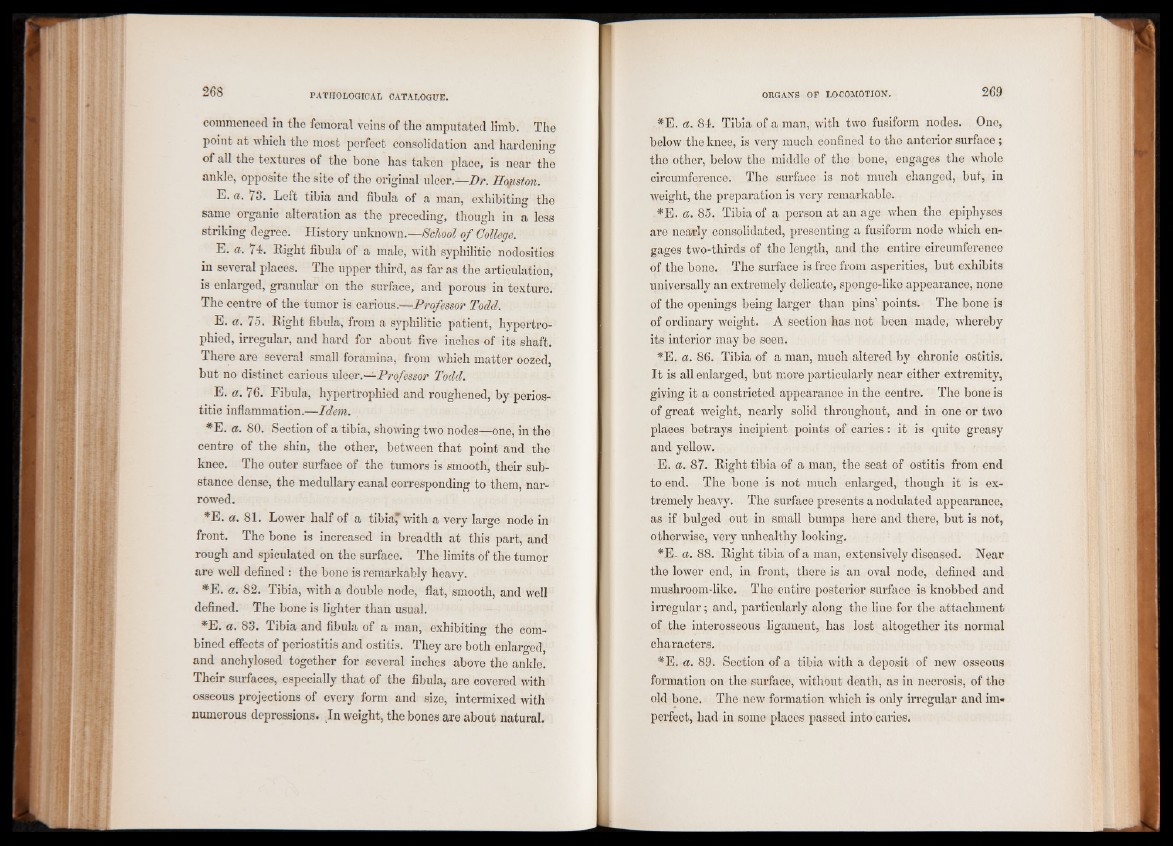
commenced in the femoral veins of the amputated limb. The
point at which the most perfect consolidation and hardening
of all the textures of the bone has taken place, is near the
ankle, opposite the site of the original ulcer.—Dr. Houston.
E. a. 78. Left tibia and fibula of a man, exhibiting the
same organic alteration as the preceding, though in a less
striking degree. History unknown.—School of College.
E. a. 74. Right fibula of a male, with syphilitic nodosities
in several places. The upper third, as far as the articulation,
is enlarged, granular on the surface, and porous in texture.
The centre of the tumor is carious.—Professor Todd.
E. a. 75. Right fibula, from a syphilitic patient, hypertrophied,
irregular, and hard for about five inches of its shaft.
There are several small foramina, from which matter oozed,
but no distinct carious ulcer.-—Professor Todd.
E. a. 76. Fibula, hypertrophied and roughened, by perios-
titie inflammation.—Idem.
*E. a. 80. Section of a tibia, showing two nodes—one, in the
centre of the shin, the other, between that point and the
knee. The outer surface of the tumors is smooth, their substance
dense, the medullary canal corresponding to them, narrowed.
*E. a. 81. Lower half of a tibiaf with a very large node in
front. The bone is increased in breadth at this part, and
rough and spiculated on the surface. The limits of the tumor
are well defined : the bone is remarkably heavy.
*E. a. 82. Tibia, with a double node, flat, smooth, and well
defined. The bone is lighter than usual.
*E. a. 83. Tibia and fibula of a man, exhibiting the combined
effects of periostitis and ostitis. They are both enlarged,
and anchylosed together for several inches above the ankle.
Their surfaces, especially that of the fibula, are covered with
osseous projections of every form and size, intermixed with
numerous depressions. In weight, the bones are about natural.
#E. a. 84. Tibia of a man, with two fusiform nodes. One,
below the knee, is very much confined to the anterior surface ;
the other, below the middle of the bone, engages the whole
circumference. The surface is not much changed, but, in
weight, the preparation is very remarkable.
-*E. a. 85. Tibia of a person at an age when the epiphyses
are nearly consolidated, presenting a fusiform node which engages
two-thirds of the length, and the entire circumference
of the bone. The surface is free from asperities, but exhibits
universally an extremely delicate, sponge-like appearance, none
of the openings being larger than pins’ points. The bone is
of ordinary weight. A section has not been made, whereby
its interior may be seen.
*E. a. 86. Tibia of a man, much altered by chronic ostitis.
It is all enlarged, but more particularly near either extremity,
giving it a constricted appearance in the centre. The bone is
of great weight, nearly solid throughout, and in one or two
places betrays incipient points of caries: it is quite greasy
and yellow.
E. ci. 87. Right tibia of a man, the seat of ostitis from end
to end. The bone is not much enlarged, though it is extremely
heavy. The surface presents a nodulated appearance,
as if bulged out in small bumps here and there, but is not,
otherwise, very unhealthy looking.
*E. a. 88. Right tibia of a man, extensively diseased. Near
the lower end, in front, there is an oval node, defined and
mushroom-like. The entire posterior surface is knobbed and
irregular; and, particularly along the line for the attachment
of the interosseous ligament, has lost altogether its normal
characters.
*E. a. 89. Section of a tibia with a deposit of new osseous
formation on the surface, without death, as in necrosis, of the
old bone. The new formation which is only irregular and im«
perfect, had in some places passed into caries.